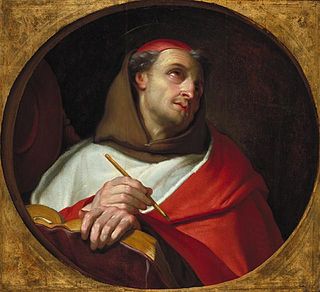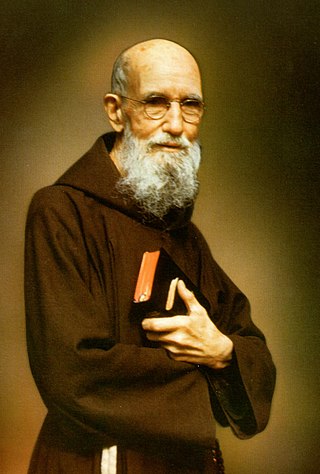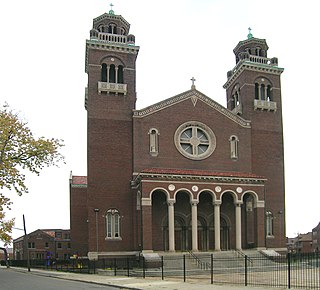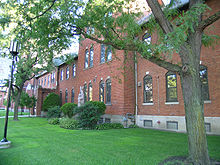
Bonaventure, OFM was an Italian Catholic Franciscan bishop, cardinal, scholastic theologian and philosopher.

The Order of Friars Minor Capuchin is a religious order of Franciscan friars within the Catholic Church, one of three "First Orders" that reformed from the Franciscan Friars Minor Observant, the other being the Conventuals (OFMConv). Franciscans reformed as Capuchins in 1525 with the purpose of regaining the original Habit (Tunic) of St. Francis of Assisi and also for returning to a stricter observance of the rule established by Francis of Assisi in 1209.

The Poor Clares, officially the Order of Saint Clare, originally referred to as the Order of Poor Ladies, and also known as the Clarisses or Clarissines, the Minoresses, the Franciscan Clarist Order, and the Second Order of Saint Francis, are members of a contemplative Order of nuns in the Catholic Church. The Poor Clares were the second Franciscan branch of the order to be established. Founded by Clare of Assisi and Francis of Assisi on Palm Sunday in the year 1212, they were organized after the Order of Friars Minor, and before the Third Order of Saint Francis for the laity. As of 2011, there were over 20,000 Poor Clare nuns in over 75 countries throughout the world. They follow several different observances and are organized into federations.

Basilica of Sainte Anne de Détroit (Sainte-Anne-de-Détroit) was founded July 26, 1701 by French colonists in New France, and is the second-oldest continuously operating Roman Catholic parish in the United States. The current Gothic Revival cathedral-styled church, built in 1886, is located at 1000 St. Anne Street in Detroit, Michigan, in the Hubbard-Richard neighborhood, near the Ambassador Bridge, and the Michigan Central Station. At one time it was the seat of a diocese that included French territory in Ontario, Canada south of the Detroit River.

St. Lawrence Seminary High School is a preparatory high school operated by the Province of St. Joseph of the Capuchin Order at Mount Calvary, Wisconsin. The school is in the Archdiocese of Milwaukee. It is an all-male boarding school, with approximately 225 students enrolled in grades 9 through 12. The school's mission is to prepare its male students for vocations in the Catholic Church.

Solanus Casey, OFM Cap, born Bernard Francis Casey, was an American religious priest of the Order of Friars Minor Capuchin. He was known during his lifetime as a healer for his great faith and his abilities as a spiritual counselor, but especially for his great attention to the sick, for whom he celebrated special Masses. The friar was much sought-after and revered, especially in Detroit, where he resided. He was also a noted lover of the violin, a trait he shared with his eponym, Saint Francis Solanus.

Innocenzo da Berzo, born Giovanni Scalvinoni, was an Italian Roman Catholic priest and a professed member of the Order of Friars Minor - or Capuchin branch of the Franciscan Order. Scalvinoni assumed his new religious name upon his profession as a Capuchin friar.

José María of Manila was a Filipino-born Spanish Catholic priest and friar of the Order of Friars Minor Capuchin. He was martyred in the early phase of the Spanish Civil War, and is the third Filipino to have been declared blessed by the Roman Catholic Church.

St. Albertus Roman Catholic Church is in the Forest Park neighborhood of Detroit, Michigan. It was designated a Michigan State Historic Site in 1974 and listed on the National Register of Historic Places in 1978.

Benedict Joseph Groeschel, C.F.R. was an American Franciscan friar, Catholic priest, retreat master, author, psychologist, activist, and television host. He hosted the television talk program Sunday Night Prime on the Eternal Word Television Network, as well as several serial religious specials.

St. Josaphat Roman Catholic Church is a Roman Catholic church located at 715 East Canfield Street in Detroit, Michigan. It was listed on the National Register of Historic Places in 1982 and designated a Michigan State Historic Site in 1985. Since 2013, it has been one of two churches that comprise Mother of Divine Mercy Parish.

The St. Theresa of Avila Roman Catholic Church is a church located at 8666 Quincy Street in Detroit, Michigan. It was listed on the National Register of Historic Places in 1989.

The Assumption of the Blessed Virgin Mary Church is a Catholic church of the Archdiocese of Detroit located at 13770 Gratiot Avenue in Detroit, Michigan. It is commonly known as the Assumption Grotto Church. The church community was founded in the 1830s, and the present building completed in 1929, designated a Michigan State Historic Site in 1990 and listed on the National Register of Historic Places in 1991.

St. Joseph's Church, also known as St. Joseph & St. Patrick Church, is a historic Roman Catholic church complex at 704-708 Columbia Street in Utica, Oneida County, New York. The complex consists of the church, St. Joseph's Parochial School (1885), St. Joseph's Parochial Residence (1906), and Parish Convent building (1891). The parish is part of the Roman Catholic Diocese of Syracuse.
The Church of Our Lady Queen of Angels is a former Roman Catholic parish church under the authority of the Roman Catholic Archdiocese of New York, located at 228 East 113th Street in Manhattan, New York City.

St. Francis Solanus Mission is a historic mission on W. Lake Street in Petoskey, Michigan. It is the only existing building in the Arbre Croche district dating from the time of Bishop Frederic Baraga, and is the oldest building still standing in Petoskey, as well as one of the oldest in northern lower Michigan. The mission was added to the National Register of Historic Places in 1972.

Dominic Pangborn is a Korean-American artist and graphic designer.

The Capuchin Soup Kitchen (CSK) is a religiously affiliated soup kitchen and non-profit organization located in Detroit, Michigan. It was founded by the Capuchin friars to provide food for the poor during the Great Depression and is sponsored by the Capuchin Franciscan Province of St. Joseph. While it was initially established as a soup kitchen, CSK now includes a food and clothing bank, a drug rehabilitation program, and an after school and summer youth program. Through its various ministries CSK serves approximately 560,000 individuals each year.





















